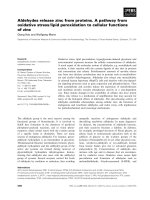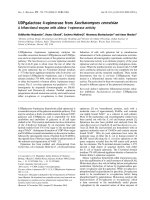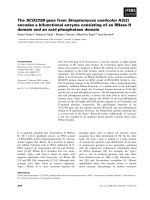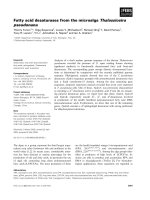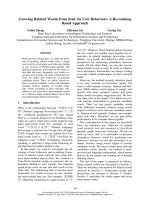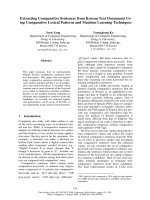Báo cáo khoa học: "Percutaneous heartworm removal from dogs with severe heart worm (Dirofilaria immitis) infestation" doc
Bạn đang xem bản rút gọn của tài liệu. Xem và tải ngay bản đầy đủ của tài liệu tại đây (4.24 MB, 6 trang )
JOURNAL OF
Veterinary
Science
J. Vet. Sci. (2008), 9(2), 197
202
*Corresponding author
Tel: +82-33-250-8681; Fax: +82-33-244-2367
E-mail:
Percutaneous heartworm removal from dogs with severe heart worm
(Dirofilaria immitis) infestation
Seung-Gon Lee, Hyeong-Sun Moon, Changbaig Hyun
*
Section of Small Animal Internal Medicine, Institute of Veterinary Medicine, School of Veterinary Medicine, Kangwon
National University, Chuncheon 200-701, Korea
Canine heart worm disease is often life-threatening due
to its various complications, including right side heart fail-
ure, caval syndrome and pulmonary eosinophilic granulo-
matosis. Several preventive medications and melarsomine
have been developed and they are very effective to control
heartworm infestation. However, in a case of severe in-
festation, melarsomine therapy often results in an un-
favorable outcome because of the severe immune reaction
caused by rapid killing of the adult worm. Surgical re-
moval and an interventional method using flexible alli-
gator forceps have been well described in the literature.
Despite the usefulness of mechanical removal using flexi-
ble alligator forceps, the methodology still needs to be up-
graded for increasing the applicability for treating dogs
with severe infestation. We describe herein a newly devel-
oped percutaneous removal method for heartworms and
this was successfully applied to 4 dogs with severe heart-
worm infestation. The follow-up studies also showed fa-
vorable outcomes with no complications.
Keywords: caval syndrome, dirofilariasis, dogs, heartworm, per-
cutaneous removal
Introduction
The mainstays of heartworm treatment for small animals
are monthly macrolide preventives, adulticidal ther-
apeutics (i.e. melarsomine and thiacetarsamide) and me-
chanical heartworm removal with using retrieval devices
(known as worm embolectomy), depending on the severity
of the heartworm infestation [1,4,5,9]. The efficacy of mel-
arsomine for adulticidal therapy has already been well de-
scribed in the literature [6], although the adverse effects re-
lated to adulticidal treatment (i.e. pulmonary thromboemb-
olism due to rapid worm killing) are often frustrating for
practitioners [7]. Despite the excellent efficacy of melarso-
mine, the survival of residual heart worms after 2 to 3 mel-
arsomine injections has also been well described in liter-
ature [1]. However, adulticidal therapy is generally not ac-
cepted in cases of severe infestation because of the severe
immune response from the rapid killing of worms. There-
fore, either mechanical or surgical heartworm removal is
indicated in severe cases of heartworm infestation. Mecha-
nical removal using retrieval devices (i.e. alligator forceps,
a basket retrieval device or a loop snare device) has been
successfully applied in the veterinary field [2,3,8]. The
main advantages of this method are the reduced invasive-
ness of the procedure, less damage to the vascular endothe-
lium and a shorter duration of general anesthesia [1]. A re-
cent study found the rate of worm removal by using alli-
gator forceps was 91.4% during 30.0 ± 7.6 min of proce-
dure time [10]. Despite these advantages of mechanical re-
moval (worm embolectomy) over surgical removal, these
methods still need further improvement to obtain better ac-
cessibility to the pulmonary arteries, to minimize the
bleeding that occurs during catheterization and for better
heartworm removal. Therefore in this study, we developed
a new modified percutaneous heartworm removal method
and we successfully applied it to 4 dogs with severe heart-
worm infestation. The subsequent follow-up studies found
that this method is a good alternative treatment for severe
heartworm infestation.
Materials and Methods
Procedure for percutaneous heartworm removal
To minimize the side effects of the procedure, all the dogs
were premedicated with aspirin (5 mg/kg, BID; Shin-
poong, Korea), clopidogrel hydrogen sulfate (1 mg/kg,
PO, SID; Sinil Pharmaceutical, Korea) and prednisolone
(0.5 mg/kg, BID, PO; Daewoo Pharmaceutical, Korea)
from the week prior to the heartworm removal procedure.
Heparin (100 U/kg, SC, SID; Greencross, Korea) was also
administered at the day prior to the procedure. The dogs
were premedicated with atropine (0.05 mg/kg, SC; Dae-
198 Seung-Gon Lee et al.
Fig. 1. The heartworm removal devices used in this study. (A)
Endoscopic grasping forceps. (B) Flexible three wires nail-tip-
p
ed forceps.
Fig. 2. The procedure for mechanical heartworm removal. (A)
After achieving surgical anesthesia, venipuncture was performe
d
at the right jugular vein with an 18G needle. Then a guidewire
was inserted into the needle and this was located at the pulmonar
y
artery. (B) An introducer sheath was inserted to the right externa
l
j
ugular vein with guidance of a pre-placed guidewire, and the
sheath was located at the pulmonary artery. (C) The guide cathe-
ter was then removed from the sheath. (D) The sheath was tempo
-
rarily tied with simple interrupted suture.
Fig. 3. The procedure for mechanical heartworm removal (conti-
nued). (A) After the sheath was inserted into the right cardiac
chamber or pulmonary artery, the removal device was inserted
into the sheath. (B) Heartworm removal was performed at the
p
ulmonary artery with fluoroscopic guidance. (C) The heart-
worms were removed from the sheath. (D) The mechanically re-
moved heartworms. E: An introducer sheath used in this study.
woo Pharmaceutical, Korea) and diazepam (0.5 mg/kg;
Daewon Pharmaceutical, Korea); this was followed by in-
duction of anesthesia with propofol (4 mg/kg; Jeil
Pharmaceutical, Korea). After tracheal intubation, the an-
esthesia was maintained by isoflurane with a 2-5% concen-
tration depending on the dog's size. The animal test subject
was mechanically ventilated at a rate of 30 times per mi-
nute with using a volume-cycled respirator (MDS Matrix
3000; Hallowell, USA). After achieving surgical anes-
thesia, venipuncture was performed at the right jugular
vein with an 18G needle. A guidewire (COOK, USA) was
inserted into the needle and this was located at the pulmo-
nary artery. Under fluoroscopy, the guidewire was pushed
to the cranial vena cava and right atrium, and then the tip of
the guidewire was nosed down and advanced to the right
ventricle and pulmonary artery (Fig. 1). An introducer
sheath (Flexer Tuohy-Borst Side-Arm Introducer; COOK,
USA) was inserted to the right external jugular vein with
guidance of the pre-placed guidewire and this was located
at the pulmonary artery (Fig. 2). The guide wire was then
removed from the jugular vein. Either an endoscopic
grasping forceps (FG-53SX-1; Olympus, Japan) or a flexi-
ble three wires nail tipped forceps (Rosot, USA) was in-
serted into the introducer and this was used to grasp the
heartworm under fluoroscopic guidance (Fig. 3). Initially,
the heartworm was removed from the pulmonary artery.
After the heartworm was no longer being retrieved from
the pulmonary artery, the introducer was pulled back to the
right ventricle. The heartworm was then removed from the
right ventricle. Lastly, the introducer was pulled back to the
right atrium and the worm was removed. After the proce-
dure, the venipunctured jugular vein was tightly tied with a
surgical nylon.
Results
Case 1: The patient was an 8-year-old intact female Jindo
dog (18.5 kg BW). The dog showed clinical signs of ano-
rexia, depression, severe dyspnea and severe ascites. Heart
auscultation revealed a grade IV/VI systolic regurgitant
murmur on the right apex. The main ECG findings were the
presence of an S wave in leads I, II and III, suggesting right
ventricular enlargement. The main laboratory findings
were anemia, leukocytosis with eosinophilia, hypopro-
teinemia, prerenal azotemia (blood urea nitrogen: 50
mg/dl, creatinine: 2.5 mg/dl) and mildly increased hepatic
Percutaneous heartworm removal from dogs with severe heart worm (Dirofilaria immitis) infestation 199
Fig. 4. Images from Case No. 2. (A) The heartworms (8 females,
7 males) removed from the right atrium with a single retrieval.
(B) The urine before and after (inset) the heartworm removal.
The dog's hemoglobinuria disappeared after the heartworm
removal.
Fig. 5. Electrocardiograms (ECG) from Case No. 2. (A) The EC
G
recorded before the heartworm removal revealed normal sinus
rhythm with occasional ventricular premature complexes (the
4th, 5th, 7th 8th and 10th QRS complexes). (B) The heart rhyth
m
returned to sinus rhythm. No ventricular premature complexes
were recorded on the 1 h ECG recordings.
Fig. 6. Echocardiographic evaluation of Case 2 before and afte
r
the heartworm removal (right parasternal short axis view, righ
t
outflow tract level) Left: before the procedure, many heartworm
s
(arrowheads) are visible in the right ventricular outflow tract an
d
p
ulmonary arteries. Right: after the procedure, no heartworms
are visible in the right ventricular outflow tract and pulmonary
arteries.
enzymes (alanine transaminase: 80 IU/l, aspartate trans-
aminase: 140 IU/l). Abdominal fluid analysis revealed a
blood tinged modified transudate. The immunological
tests for adult worms and microfilaria were positive. On the
thoracic radiography, the right atrium and caudal vena cava
were severely enlarged, although the lung fields were rela-
tively clear. An echocardiographic study found a severe
heartworm infestation in the right atrium and ventricle, and
tricuspid regurgitation was also noted. In this dog, 13
heartworms (8 females, 5 males) were removed from the
heart. After the heartworm removal, the dog was treated
with prednisolone (0.5 mg/kg, BID, PO), amoxicillin (20
mg/kg, BID, PO; Chong Kun Dang, Korea) and heparin
(100 U/kg, SC, SID) for 3 days. The dog's abdominal fluid
was removed (300ml). This dog was also medicated with
diuretics (furosemide, 2.5 mg/kg, BID; Handok, Korea)
and nitroglycerine (transdermal patch, 1/8 of 25 mg/h, ev-
ery other 12 h; Daewoong Pharmaceutical, Korea) to pre-
vent further abdominal fluid accumulation. On the echo-
cardiography taken 2 weeks after heartworm removal, a
heartworm still existed in the right ventricle and pulmo-
nary artery and the dog's fluid accumulation still persisted.
Adulticidal therapy (melarsomine, 2.5 mg/kg, IM; Merial,
USA) was done for 2 consecutive days with cage rest at a
month after the heartworm removal. For 2 months, the dog
was treated with furosemide (3 mg/kg, PO, BID) and ena-
lapril (0.5 mg/kg, Cellart Pharm, Korea) to reduce the right
atrial dilation and the abdominal fluid accumulation; dur-
ing these 2 months, the dog was treated with prednisolone
(0.5 mg/kg, PO, BID) and clopidogrel hydrogen sulfate (18
mg/kg, PO, SID). No worm was detected on the echo-
cardiography that performed a month after the adulticidal
treatment. No further fluid accumulation was observed af-
ter 2 months of the diuretic therapy. The dog showed a neg-
ative reaction on the antigen test for adult worm and
Knott's test for microfilaria; these tests were done 4 months
after the heartworm removal.
Case 2: The patient was a 3-year-old intact male Boston
terrier (4.9 kg of body weight). The dog showed clinical
signs of severe dyspnea, occasional cough, hemoglobi-
nuria (Fig. 4B) and exercise intolerance. On thoracic aus-
cultation, a grade IV/VI systolic murmur with a split S2
sound was heard at the right cardiac apex. Electrocardio-
graphic (ECG) studies showed sinus tachycardia (145 per
min) with occasional ventricular premature contractions
(Fig. 5A). The hemogram revealed hemolytic anemia and
leukocytosis with eosinophilia. The blood biochemistry re-
vealed increased hepatic enzymes (alanine transaminase,
120 IU/l; aspartate transaminase 110 IU/l), azotemia
(blood urea nitrogen, 41 mg/dl; creatinine, 1.5 mg/dl) and
bilirubinemia (1.5 mg/dl). On the heartworm antigen test
(SNAP kit; IDEXX Laboratories, USA), the dog showed a
positive reaction with microfilaria being observed on the
direct smear. On the thoracic radiography, a remarkable en-
largement of the pulmonary artery with pruning and mod-
erate right atrial and ventricular enlargement, and the lung
fields showed an interstitial pattern. An echocardiographic
200 Seung-Gon Lee et al.
study showed the enlargement of the pulmonary artery and
right atrium, the movement of heartworm, and especially
in the right outflow tract, and the turbulent flow at the tri-
cuspid and pulmonary valve areas. In this dog, 15 heart-
worms (8 females, 7 males) were removed from the right
atrium at a single retrieval (Fig. 4A). Seven more worms
were removed with successive retrievals from the right
ventricle and pulmonary artery. Since the cardiac con-
tractibility suddenly dropped, we stopped the procedure.
After the removal of the introducer and retrieval device, the
cardiac contractibility returned to normal. The dog was
then treated with prednisolone (0.5 mg/kg, BID, PO),
amoxicillin (20 mg/kg, BID, PO) and heparin (100 U/kg,
SC, SID) for 3 days and then the dog was changed to pre-
dnisolone, amoxicillin, aspirin (5 mg/kg, PO, BID) and
clopidogrel hydrogen sulfate (18 mg/kg, PO, SID) for an-
other 7 days. On the clinical examination immediately af-
ter the heartworm removal, the systolic murmur dis-
appeared on the thoracic auscultation. More interestingly,
the ventricular premature contractions also disappeared af-
ter the heartworm removal (Fig. 5B). The hemoglobinuria
no longer persisted from the next day after the heartworm
removal (Fig. 4B). For the first week of the follow-up
study, the dog showed dramatic improvement of its phys-
ical condition without any complications. The dog was
then medicated with a preventive dose of ivermectin (PO,
monthly; Merial, USA). Subsequent melarsomine therapy
(2 consecutive injections) was performed at a month after
heartworm removal. The dog showed negative reaction on
the antigen test for adult worm and on Knott's test for mi-
crofilaria; these tests were performed 4 months after the
heartworm removal.
Case 3: The patient was a 4-year-old intact female
Yorkshire terrier (5.5 kg of body weight). The dog showed
clinical signs of tachypnea, tachycardia, depression, noc-
turnal cough and severe exercise intolerance. On the thora-
cic auscultation, a grade V/VI systolic murmur with pre-
cordial thrills was heard at the right cardiac apex. No par-
ticular abnormalities were observed on the ECG except for
tachycardia (190 per min). No significant abnormalities
were observed on the routine CBC and biochemistry tests.
On the heartworm antigen test, the dog showed a positive
reaction with the observation of microfilaria on the direct
smear. Thoracic radiography revealed right sided cardiac
enlargement (reverse-D shape) with a severe enlargement
of the right atrium (the central venous pressure was 22 cm
H
2
O at presentation), tortuous and pruned right and left
pulmonary arteries with increased density of the lung
fields. Echocardiography revealed a heavy heartworm in-
festation in the right atrium, right ventricle and pulmonary
artery. With performing our procedure, 22 heartworms (15
females, 7 males) were removed from the right atrium,
right ventricle and pulmonary artery. After the heartworm
removal, the dog was treated as was described in Case 1. In
addition, the dog was medicated with diuretics (2 mg/kg
PO, BID) and nitroglycerine (transdermal patch, 1/8 of 25
mg/h, every other 12 h) to reduce the preload of the right at-
rium for 2 weeks after the heartworm removal. On the clin-
ical examination performed 2 weeks after the procedure,
the condition of dog was clinically improved, but the dog
still showed mild respiratory signs. Prednisolone (0.5
mg/kg, PO, BID) and cough suppressant (codeine, 0.2
mg/kg, PO, TID; Guju Pharmaceutical, Korea) were pre-
scribed for another 2 weeks with administration of heart-
worm preventive medication (ivermectin, PO, monthly).
Subsequent melarsomine therapy was performed after the
dog's condition was stabilized. The owner reported the dog
physically returned to normal after a short time.
Case 4: The patient was a 4-year-old intact male Siberian
Husky (48 kg of body weight). The dog showed clinical
signs of tachypnea (90 respiratory rate/m), persistent
cough and exercise intolerance. No abnormal sound was
detected on the cardiac auscultation. The ECG showed oc-
casional bundle branch blocks. For the hematology, the
dog showed leukocytosis with eosinophilia. The blood
chemistry tests showed increased hepatic enzyme (alanine
transaminase, 320 IU/l; aspartate transaminase 150 IU/l)
and an increased phosphorus concentration (7.2 mg/dl).
Although the dog showed a positive reaction on the antigen
test, negative findings were observed on the concentration
testing method and by direct observation. Strangely, on the
thoracic radiography, no enlargement of the cardiac silhou-
ette was observed, although the dog showed severe vas-
cular and pulmonary changes, including pruned and tor-
tuous pulmonary arteries and nodular infiltration on both
lung fields. On the echocardiography, only a few worms
were detected in the pulmonary arteries. No other abnor-
malities were observed on further echocardiographic
studies. However, in this dog, 18 heartworms (15 females,
3 males) were removed from the pulmonic artery. The dog
was treated with the prescription described earlier. On the
physical examination performed a day after the heartworm
removal, the respiration rate had returned to the normal
range (25- 35/min) and the dog did not cough. After a week
of care in our clinic, the dog was then released with the pre-
scription described earlier. Monthly heartworm preventive
medication with ivermectin was also prescribed. Subse-
quent melarsomine therapy was performed after the dog's
condition was stabilized. No further deterioration was re-
ported by the owner.
Discussion
Mechanical heartworm removal using a flexible alligator
forceps has previously been successfully applied [2,8,10].
A subsequent study has also found this method is safer and
more efficient than melarsomine administration, if it is ap-
plied under fluoroscopic guidance by a skilled practitioner
Percutaneous heartworm removal from dogs with severe heart worm (Dirofilaria immitis) infestation 201
[1,10]. However, subsequent melarsomine administration
for adequate worm destruction is still required after worm
removal [1]. The main advantages to this technique are i)
the minimal risk of potential arsenic toxicity by the adulti-
cidal therapy to asymptomatic patients, and ii) the minimal
risk of thromboembolism, while main drawbacks are i) the
need for general anesthesia and fluoroscopy, ii) the require-
ment that the personnel performing the procedure be high-
ly skilled, and iii) the subsequent melarsomine administra-
tion.
Despite these advantages over conventional arsenic ther-
apy, mechanical worm removal often produces frustrating
outcomes. However, this new method of mechanical re-
moval is advantageous over the method used by Sasaki et
al. [8].
Firstly, this procedure does not require venotomy to ac-
cess to the jugular vein, so the bleeding associated with the
insertion and retraction of the heartworm removal device
was remarkably reduced. Furthermore, surgical closure is
not necessary since this procedure doesn't required veno-
tomy.
Secondly, this procedure has better accessibility and it is
safer. For this procedure, because the introducer catheter
was pre-placed to the area of the pulmonary artery or right
ventricle with using a very flexible guidewire, the removal
device can easily access to the pulmonary artery without
effort. This can minimize the vascular and intra-cardiac
damage that is caused by the insertion of the removal de-
vice and this can save time when locating the removal de-
vice to the pulmonary artery.
Thirdly, this procedure can be done for a dog with marked
right atrial enlargement. Direct insertion of removal de-
vices is often frustrating in giant breed dogs and dogs that
have an enlarged right atrium since the device can not be
easily located into the right ventricle and pulmonary artery,
despite the flexibility of the device that's used. However,
because this procedure uses various types of guidewires
that are easier to handle and locate to the target area, the re-
moval device can be located at any place of the heart, even
though the device is more rigid than the flexible alligator
forceps.
Lastly, this procedure has better flexibility. Although we
only used two removal devices, with this procedure we can
use various types of commercially available retrieval
devices. The large size (7-8 Fr) of the introducer can ac-
commodate most types of retrieval devices that are usually
used for endoscopic foreign body removal. For instance,
removing heartworm from the smaller pulmonary arteries
with Ishihara's flexible alligator forceps is problematic
since this device needs enough space to open the jaws.
However, this can be overcome with other types of re-
trieval devices (e.g. an extraction catheter with a wire
guide), which can be applicable without the guidance of a
pre-placed introducer. Furthermore, the introducer used in
this study has a side-arm connector that enables us to mon-
itor the central venous pressure and to perform angiocar-
diography. This features helped us to adjust the fluid speed
and to delineate the vascular structures while this proce-
dure is carried out.
Despite these advantages, there is a potential risk of car-
diac arrest, and this is due to cardiac contractile dysfunc-
tion that caused by the insertion of the introducer in the
right ventricle, and especially in dogs under 5 kg of body
weight. The dog in case 2 in this study showed marked con-
tractile dysfunction when the introducer and retrieval de-
vice were placed in the right ventricle. The rigidity of the
catheter and retrieval device may induce cardiac muscular
fatigue and this may cause contractile dysfunction and sub-
sequent cardiac arrest in dogs with a small chamber (a
small sized dog). Another disadvantage is that this method
still requires subsequent melarsomine administration for
adequate worm destruction [1,7,9]. In addition, the total
cost for this procedure is more expensive than the other
method because it uses a disposable intracardiac catheter.
However a fair outcome and better accessibility may com-
pensate for these disadvantages. This method may be a
good therapeutic option for the cases with a severe heart-
worm burden and the cases with complications such as
caval syndrome or pulmonary thromboembolism.
Acknowledgments
This study was supported by the research fund from
Kangwon National University (3005055-1-1).
References
1. Atkins C. Canine heartworm disease. In: Ettinger SJ, Feld-
man EC (eds.). Textbook of Veterinary Internal Medicine.
6th ed. pp. 1118-1136, Saunders, Philadelphia, 2004.
2. Atwell RB, Litster AL. Surgical extraction of transplanted
adult Dirofilaria immitis in cats. Vet Res Commun 2002, 26,
301-308.
3. Glaus TM, Jacobs GJ, Rawlings CA, Watson ED, Calvert
CA. Surgical removal of heartworms from a cat with caval
syndrome. J Am Vet Med Assoc 1995, 206, 663-666.
4. Grieve RB, Frank GR, Stewart VA, Parsons JC, Belasco
DL, Hepler DI. Chemoprophylactic effects of milbemycin
oxime against larvae of Dirofilaria immitis during prepatent
development. Am J Vet Res 1991, 52, 2040-2042.
5. Paul AJ, Todd KS Jr, Sundberg JP, DiPietro JA, McCall
JW. Efficacy of ivermectin against Dirofilaria immitis lar-
vae in dogs 30 and 45 days after induced infection. Am J Vet
Res 1986, 47, 883-884.
6. Polizopoulou ZS, Koutinas AF, Saridomichelakis MN,
Patsikas MN, Leontidis LS, Roubies NA, Desiris AK.
Clinical and laboratory observations in 91 dogs infected with
Dirofilaria immitis in northern Greece. Vet Rec 2000, 146,
466-469.
7. Rawlings CA, Raynaud JP, Lewis RE, Duncan JR.
202 Seung-Gon Lee et al.
Pulmonary thromboembolism and hypertension after thiace-
tarsamide vs melarsomine dihydrochloride treatment of
Dirofilaria immitis infection in dogs. Am J Vet Res 1993, 54,
920-925.
8. Sasaki Y, Kitagawa H, Ishihara K, Masegi T. Improvement
in pulmonary arterial lesions after heartworm removal using
flexible alligator forceps. Nippon Juigaku Zasshi 1990, 52,
743-752.
9. Strickland KN, Atkins CE. Heartworm disease, dog. In:
Cote E (ed.). Clinical Veterinary Advisor: Dogs and Cats. 6th
ed. pp. 465-467, Saunders, Philadelphia, 2007.
10. Yoon HY, Jeong SW, Kim JY, Han HJ, Jang HY, Lee B,
Namkang HS. The efficacy of surgical treatment with flexi-
ble alligator forceps in dogs with heartworm infection. J Vet
Clin 2005, 22, 309-313.




